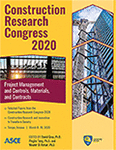Construction Research Congress 2020
Optimum Properties and Distribution of Phase Change Materials for High-Performance Concrete Buildings
Publication: Construction Research Congress 2020: Project Management and Controls, Materials, and Contracts
ABSTRACT
Phase change materials (PCMs) can be used as an effective solution in the field of high-performance building systems as they act as a means of temporary energy storage. Properties of PCMs, including melting point temperature, location within the building envelope, and orientation, play an important role in overall heating and cooling energy consumption of a building that employs PCMs. In this work, a building energy simulation model (EnergyPlus) is developed for a typical medium size U.S. office building in Houston, in which PCMs are integrated into the building envelope in a range of configurations, with the purpose of identifying the most effective configurations in terms of amount, orientation, and material properties. Overall findings indicate that annual energy consumption is reduced with an increase PCM utilization. An annual energy savings of up to 30% can be achieved in the optimal configuration when 30 to 40% of the total amount of PCM is incorporated in the external walls and the remaining portion of the total PCM is used in the roof. The results of this work help the building construction industry working in the design and construction of high-performance buildings, to select the optimum distribution of PCMs in the building envelope to achieve energy efficient building design.
Get full access to this article
View all available purchase options and get full access to this chapter.
REFERENCES
Akeiber, Hussein, Payam Nejat, Muhd Zaimi Abd Majid, Mazlan A. Wahid, Fatemeh Jomehzadeh, Iman Zeynali Famileh, John Kaiser Calautit, Ben Richard Hughes, and Sheikh Ahmad Zaki. "A review on phase change material (PCM) for sustainable passive cooling in building envelopes." Renewable and Sustainable Energy Reviews 60 (2016): 1470-1497.
ASHRAE. (2004c). 90.1 User’s Manual ANSI/ASHRAE/IESNA Standard 90.1-2004. Atlanta, GA: American Society of Heating, Refrigerating and Air-Conditioning Engineers
Auzeby, M., Wei, S., Underwood, C., Tindall, J., Chen, C., Ling, H. and Buswell, R. 2016. “Effectiveness of Using Phase Change Materials on Reducing Summer Overheating Issues in UK Residential Buildings with Identification of Influential Factors”, Energies 9(8),605, https://doi.org/10.3390/en9080605
Crawley, D., Lawrie, L., Winkelmann, F., Buhl, W., Huang, Y., Pedersen, C., Strand, R., Liesen, R., Fisher, D., Witte, M. and Glazer, J. 2001, “EnergyPlus: creating a new-generation building energy simulation program.” Energy and Buildings, 33 pp 319-331
Deru, M., Field, K., Studer, D., Benne, K., Griffith, B., Torcellini, P., Liu, B., Halverson, M., Winiarski, D., Rosenberg, M., Yazdanian, M., Huang, J. and Crawley, D., 2011, U.S. Department of Energy Commercial Reference Building Models of the National Building Stock, National Renewable Energy Laboratory
EIA, 2017, International Energy Outlook, US Energy Information Administration
Elnajjar, E. 2017. “Using PCM embedded in building material for thermal management: Performance assessment study”. Energy and Buildings 151, 28-34
Energyplus, n.d. “EnergyPlus”. Accessed June 12, 2019 https://energyplus.net/.
EIA.2015, “2012 CBECS Survey Data”. Date of publication: Jul 19, 2015. https://www.eia.gov/consumption/commercial/data/2012/index.php?view=consumption.
EIA. 2015, “A Look at the U.S. Commercial Building Stock: Results from EIA's 2012 Commercial Buildings Energy Consumption Survey (CBECS)”, Release date: March 4, 2015. https://www.eia.gov/consumption/commercial/reports/2012/buildstock/.
Hunger, M, Entrop, A.G., Mandilaras, I., Brouwers, H.J.H. and M. Founti. 2009. “The behavior of self-compacting concrete containing micro-encapsulated phase change materials”. Cement & Concrete Composites 31, 731-743.
Lei, J., Yang, J., and Yang, E. 2016. “Energy Performance of Building Envelopes integrated with Phase Change Materials for Cooling Load Reduction in Tropical Singapore.” Applied Energy, 162, pp 207-217
Marin, P., Saffari, M., Gracia, A., Zhu, X., Farid, M., Cabeza, L., Ushak, S., 2016, “Energy savings due to the use of PCM for relocatable lightweight buildings passive heating and cooling in different weather conditions.” Energy and Buildings, 129 pp 274-283
National Weather Service, 2018, “WFO Monthly/Daily Climate Data”, Last modified March 8, 2018. Accessed July 28, 2019, https://forecast.weather.gov/product.php?site=NWSissuedby=IAHproduct=CF6format=CIversion=14glosglos=0
National Oceanic and Atmospheric Administration (NOAA), n.d., “Engineering Weather Data”, Accessed July 28, 2019. http://web.utk.edu/~archinfo/EcoDesign/escurriculum/weather_data/reports/houston_tx.pdf
Sajadi, Behrang, and Amir Baniassadi. "On the effect of using phase change materials in energy consumption and CO2 emission in buildings in Iran: a climatic and parametric study." Energy Equipment and Systems 3, no. 2 (2015): 73-81.
Sanga, Y., Zhaoa, J., Suna, J., Chenb, B. and, Liub, S. 2017. “Experimental investigation and EnergyPlus-based model prediction of thermal behavior of building containing phase change material” Journal of Building Engineering 12, 259–266
Tabares-Velasco, P., Christensen, C. and Bianchi, M. 2012. “Verification and Validation of EnergyPlus Phase Change Material Model for Opaque Wall Assemblies.” Building and Environment, 54 pp 186-196.
Information & Authors
Information
Published In
Construction Research Congress 2020: Project Management and Controls, Materials, and Contracts
Pages: 1012 - 1020
Editors: David Grau, Ph.D., Arizona State University, Pingbo Tang, Ph.D., Arizona State University, and Mounir El Asmar, Ph.D., Arizona State University
ISBN (Online): 978-0-7844-8288-9
Copyright
© 2020 American Society of Civil Engineers.
History
Published online: Nov 9, 2020
Authors
Metrics & Citations
Metrics
Citations
Download citation
If you have the appropriate software installed, you can download article citation data to the citation manager of your choice. Simply select your manager software from the list below and click Download.
